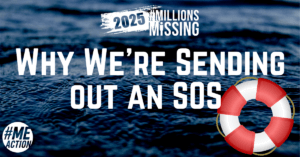Back in September, #MEAction Georgia State Chapter partnered with the Centers for Disease Control and Prevention (CDC) and Emory School of Nursing to host, Voice of the Patient: A Panel Discussion with #MEAction Georgia.
This event was a continuation of #MEAction Georgia’s #MillionsMissing 2024: #TeachMETreatME programming. Erin Lee and Liz Burlingame of the #MEAction Georgia worked with Dana Brimmer of the CDC to coordinate this event. This panel was facilitated by Elizabeth Unger, PhD, MD, Chief Chronic Viral Diseases Branch, CDC and the panelists included Jes Gordon and Cory Anderson, with healthy allies Nate Lee, Andrew Sweeney, and Everett Gordon.
This event is a wonderful example of when local advocacy, continued engagement, and a strong programming focus align to bring together an impactful event. We spoke with the #MEAction Georgia State Chapter to share a little bit about how this event came to be, what stood out to them, and plans for the future. Please enjoy this insight:
Why was this type of event decided upon as your #TeachMETreatME event?
With the CDC headquartered in our state/city, we are in a unique position to collaborate with them to increase awareness and education. The CDC partnered with the Emory University school of nursing to host this event with the goal of educating nursing students about ME/CFS and its connection to Long COVID. Dr. Unger of the CDC facilitated the discussion and provided medical/scientific overview while #MEAction Georgia members contributed lived experiences. The combination of facts and real-world/real people examples truly drives home the impact of the disease and the ways medical providers and researchers can impact our access to care and the quality of that care in a way that neither side can fully express on its own.
What work went into getting this type of event planned? How did you go about building relations with Emory and the CDC, in order to partner with them?
#MEAction GA has been slowly building a collaborative relationship with the CDC for years and this event was the capstone in a year that marked a significant turning point in that partnership. A year-long conversation to make the CDC’s Light Up event for Awareness Day lead to a series of events and collaborations between patients, researchers, and CDC leadership.
Event preparation was split between the CDC and #MEAction GA, with our side coordinating the patient and caregiver speakers, the slide show of patient photos, and the livestream. The CDC coordinated with Emory to secure the room, the event recording, and the promotion of the event.
What are you most proud of when it comes to this event?
I’m proud that when we approached the CDC with the proposition for an event that centered the lived-experience of people with ME to educate medical professionals, the CDC took action to make the event happen. We collaborated in a way that, we hope, can be replicated again not only in Georgia but also in other states with other universities with partners at the CDC.
One of the biggest hurdles to making this event happen is that so many of our people are too sick to show up at an event in person. Healthy allies stepped up to fill that space. One person with ME talked about her lived experience while two healthy allies shared what it’s like to be a caregiver.
What is a part of the event that really stood out to you?
Looking around the room after the presentation, every member of the ME community in attendance was engaged in conversations with members of the audience discussing everything from ways to make healthcare more accessible at systemic and personal levels to the dream of a network of social workers to coordinate care and communication between doctors. The conversations were filled with such a desire to learn more and to help. I think people on both sides felt much more connected and understood.
One of the audience members posed a question filled with misinformation about treatments. Our patient representative gave a respectful yet powerful answer that we need to be mindful not to blame the patient. It was the perfect answer and indicative of how far people with ME still have yet to go.
How do you think this type of event benefits the ME Community? Do you have any plans to build upon these relationships and any plans for the future?
More than anything else, this event humanized ME to the people in attendance. Hearing patients or caregivers talk about who we were before and what ME has taken from us, seeing patients struggle to tolerate the projections or the sound of a room of people, hearing the knowing reactions to anecdotes of struggles to access health care or support…. Symptom lists and statistics can provide an understanding of what ME is, but the people show and tell you what it does. From my conversations with audience-members afterwards, every single person in attendance left with a much more nuanced perspective on what the patient/caregiver experience is truly like and what their research/medical care has the potential to give us. Purpose became personal instead of purely academic.
In terms of future plans, we hope to further refine this format and recreate it at multiple medical schools in the area. We are in ongoing conversation with the CDC about how we can best support each other’s work and our mutual goals- this year was a significant turning point in that partnership and we hope to see it grow from here.
———
You can watch the full panel recording here. Please note the audio recording of this video is not perfect, so it may be hard to watch for people sensitive to sounds. There are captions, so you can watch the video on mute if you prefer.






1 thought on “#MEAction Georgia: Voice of the Patient in Coordination with CDC & Emory School on Nursing”
Thank you, MEAction for helping to amplify this first-of-its-kind collaboration between MEAction GA, the CDC and Emory University!
Comments are closed.